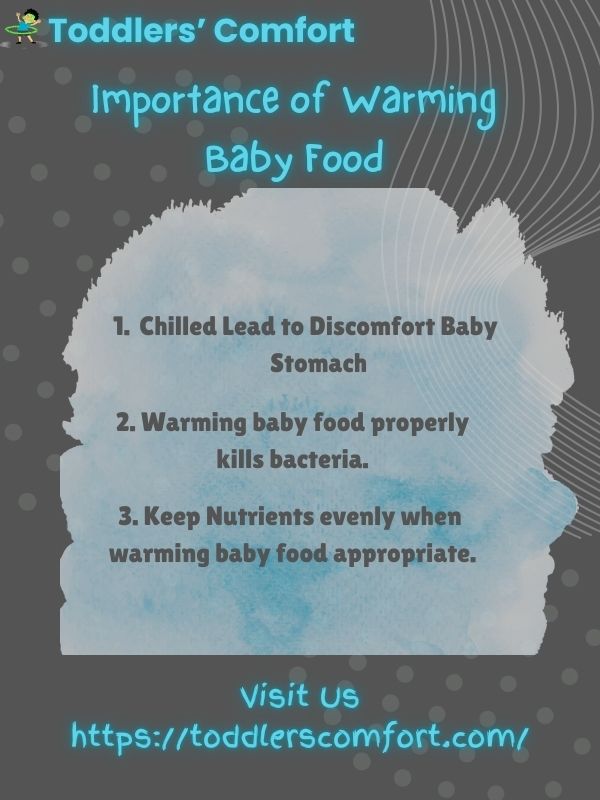“Am I warming my baby’s food correctly?” or “How to warm baby food from the fridge? These types of questions are very common among parents during the beginning of parenthood. As per the survey conducted by BabyCenter, over 60% of new parents admitted they were unsure of the proper techniques for warming baby food, often fearing they might overheat it or, worse, underheat it, leading to potential health risks. Moreover, according to U.S. Food and Drug Administration, every year in the U.S., children under 10 years suffer from near about 800,000 illnesses, which originate especially from foods.
The simple task of warming baby food can feel overwhelming due to concerns about nutritional loss, uneven heating, and food safety. Babies have sensitive digestive systems, and ensuring their food is warmed just right can play a big role in their comfort and well-being. We will explore different methods on how to warm baby food safely, why it is important, and how to avoid common risks. From microwaves to stovetops, we will guide you step-by-step so you can confidently provide the best for your little one.
The Importance of Warming Baby Food

Why is warming baby food such a big deal? It might seem like a small step, but it holds great importance for your baby’s health and comfort. For starters, food served straight from the fridge can be too cold and unpleasant for your baby to eat. Chilled food is less appealing and may be harder for babies to digest, potentially leading to stomach discomfort.
But it is not just about comfort. Warming baby food properly can also help eliminate harmful bacteria that may have grown during storage. The CDC notes that foodborne illnesses are a serious risk for young children due to their developing immune systems. Properly maintained and warmed food can reduce the chances of bacteria, like E. coli or Salmonella, sneaking into your baby’s meal.
Lastly, warming baby food maintains its nutritional value. Foods heated evenly and at the right temperature are more likely to retain essential nutrients, like vitamins and minerals. However, overheating can break down those nutrients, diminishing the quality of your baby’s meal.
How to Warm Baby Food in Different Methods?
When it comes to warming baby food, there are now two common reliable methods practiced by experienced parents: one is by microwave and another is on the stovetop. Each method has its own advantages and drawbacks, but all are considered safe against the question asked, “How to warm baby food properly?”.
How to warm baby food in the microwave
The most common practice now performed by parents is microwaving their baby food. Because it requires less time and effort to heat up their babies’ food. However, it requires extra care to ensure even heating. Microwaves heat food unevenly, often causing “hot spots” that can burn your baby’s mouth. This is why it’s essential to stir the food frequently and test the temperature before feeding. When using the microwave to warm baby food, always use a microwave-safe container, preferably glass or ceramic.
Pros
- Fast and convenient
- Ideal for busy parents
- Suitable for most foods
Cons
- Uneven heating can cause hot spots
- Risk of overheating if not monitored carefully
- Plastic containers may leach harmful chemicals
How to warm baby food in the microwave: Step-by-Step Guide
Microwaving baby food can be quick and easy if done correctly. Here’s a step-by-step guide to help you navigate the process safely:
Prepare the Food
Before you begin, place the baby food in a microwave-safe container. Avoid using plastics unless they are clearly labeled microwave-safe, as some plastics can release harmful chemicals when heated. Glass or ceramic containers are the best options.
Heat Gradually
Set your microwave to low power or defrost mode. Heat the baby food in 10 to 15 second intervals to avoid overheating. Microwaving food for longer intervals will create some hotspots, which will lead to burning your baby’s mouth. Gentle heating in short intervals helps distribute the heat more evenly.
Stir between Each Intervals
After each heating interval, stir the food thoroughly. This not only ensures that the heat is evenly distributed but also helps to break up any hot spots. Stirring frequently is key when warming food in the microwave.
Check and Serve
After the final stir, test the food’s temperature by placing a small amount on the inside of your wrist. The food should feel warm but not hot. If it is too hot, allow it to cool for a few minutes before serving.
How to warm baby food on the Stovetop
Warming baby food on the stovetop is another great option for parents who prefer a slower, more controlled method. Unlike microwaving, stovetop heating allows you to better regulate the temperature of the food, making it less likely to overheat.
Pros
- The gentle method preserves nutrients.
- Even heating.
- Lower risk of hot spots.
Cons
- Takes longer than microwaving.
- It requires more attention.
How to warm baby food on the stovetop: Steps to follow
When using the stovetop method, follow these steps to ensure the food is warmed safely and evenly:
Prepare the Food
Transfer the baby food into a heatproof container or jar. If using a jar, make sure it’s designed to handle heat. Glass is ideal for this method as it withstands higher temperatures and heats evenly.
Heat Slowly
Fill a saucepan with water and heat it until it’s just simmering, not boiling. Place the container of baby food into the water, making sure the food itself is not in direct contact with the heat. This double-boiler method allows the food to warm gently, preserving its nutrients.
Check the Temperature
As the food warms, stir it occasionally to distribute the heat. Once it’s evenly warmed, test the temperature by placing a small spoonful on your wrist. As always, ensure it’s warm, not hot.
Serve
Once the baby food has reached the right temperature, it is ready to serve. Make sure you discard any leftover food that has already been heated.
How to Warm Baby Food from Frozen?
Reheating frozen baby food is a common practice for many parents who batch-prepare meals. However, there are a few important rules to follow when reheating from frozen. The safest way to thaw baby food is by placing it in the refrigerator overnight. This ensures a slow, even thaw that reduces the risk of bacterial growth.
For a faster method, you can submerge the frozen container in warm water or use a microwave’s defrost setting. Once thawed, warm the food using the same methods as mentioned earlier, such as stovetop or microwave. Just be sure to stir frequently and test the temperature before feeding.
When reheating baby food from frozen, it is important to only thaw the portion you plan to use. Refreezing baby food can compromise its texture and nutritional content, not to mention increase the risk of contamination.
Is it safe to warm baby food for another time?
Warming baby food more than once is generally not recommended. Reheating food multiple times can lead to bacterial growth, which can cause foodborne illnesses in your baby. Once the food has been warmed, it should be consumed within two hours or discarded if left at room temperature.
If you have leftover baby food after warming, it is best to refrigerate it immediately in an airtight container and consume it within 24 hours. However, it is always better to only warm the amount of food you plan to serve to avoid waste and potential health risks.
How long does baby food last: refrigerator vs. freezer?
Knowing how long baby food can be stored is essential for maintaining its freshness and safety. In the refrigerator, homemade baby food can last up to 48 hours, while store-bought baby food should be consumed within 24 hours after opening. Always store baby food in airtight containers to prevent contamination and maintain freshness.
In the freezer, baby food can last for up to 3 months. Freezing baby food helps preserve its nutrients and allows you to prepare meals in advance, but it’s important to thaw and reheat it properly to ensure safety.
| Food | Refrigerator | Freezer |
| Formula (stored in individual baby bottles) | 2 days | Not Recommended |
| Whole milk | 5 days | 3 months |
| Reconstituted evaporated milk | 3 to 5 days | Not Recommended |
| Strained fruits and vegetables | 2 to 6 days | 6 to 8 months |
| Strained meats and eggs | 1 day | 1 to 2 months |
| Meat/vegetable combinations | 1 to 2 days | 1 to 2 months |
| Homemade baby foods | 1 to 2 days | 3 to 4 months |
Conclusion
Warming baby food may seem like a small task, but it is crucial for your baby’s comfort, safety, and nutrition. Whether you choose to use the microwave, stovetop, or another method, always be mindful of how the food is heated to avoid hot spots and nutrient loss. Stirring frequently, heating in short intervals, and testing the temperature before serving are essential steps in ensuring your baby’s food is perfect every time. By following these simple guidelines, you can confidently serve your baby warm, nutritious meals every day.
FAQ on How to Warm Baby Food
How do you warm up baby food from the fridge?
Simply heat the food in the microwave or on the stovetop. Use short intervals in the microwave, stirring in between, or warm it gently in a double boiler on the stove. Always test the temperature on your wrist before serving to your baby.
Are you supposed to heat baby food?
Yes, warming baby food makes it more enjoyable and easier to digest for your baby. Some foods, like yogurt, can be served cold, but generally, warmed food is best for comfort and taste.
How to heat up baby food on the go?
Use a portable bottle warmer or an insulated food jar to keep the food warm. In a pinch, you can ask for hot water at a café to warm the food using the double-boiler method.
Can you warm up baby food in a jar?
Yes, ensure the jar is microwave-safe or heat-resistant. Heat in short bursts or in simmering water, stirring often. Always check the temperature before serving to avoid burning your baby.


